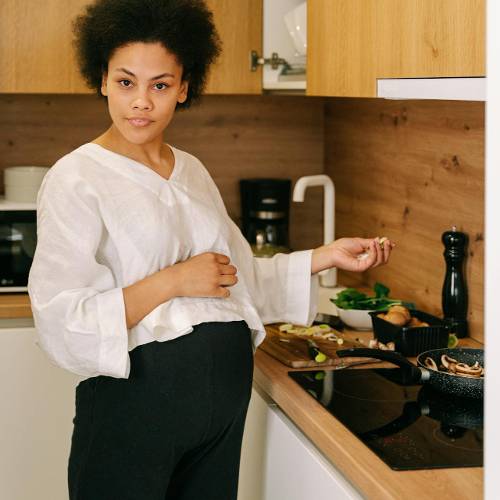Are you expecting a bundle of joy soon? Chances are you’re daydreaming about holding your newborn soon amidst eating right and Doctor or OB checkups. Several tests are there to determine you and your baby’s health.
Pregnancy glucose screening is one such test that confirms the presence of gestational diabetes. About 2-10% of pregnant women may get gestational diabetes in the US alone. So, it’s crucial to get the screening done.
Apart from genetics, diet plays a role in maintaining blood sugar levels. Knowing what to eat before glucose tests and eating healthy during pregnancy, in general, can help maintain these levels. Keep reading as I discuss what you can eat or avoid before the test.
What Is a Pregnancy Glucose Test?
A pregnancy glucose test, aka glucose screening test, is a simple procedure to check for gestational diabetes. It develops during pregnancy when the body can’t make enough insulin or use the insulin it does produce effectively.

Pregnancy glucose tests are also called:
- Oral Glucose Tolerance Test (OGTT)
- GDM dx
- Glucola test
- Glucose screening
- Gestational diabetes screening
- One-hour glucose challenge test
The early detection of gestational diabetes can prevent risks to the mother’s health and the baby. The test is done to prevent the following complications:
- Larger than average baby (macrosomia)
- Difficulty delivering the baby vaginally (and increased risk of needing a C-section)
- Preeclampsia
- Low blood sugar in the newborn
Glucose Screening vs. Glucose Tolerance Test
The glucose screening test is done after consuming a sugary drink. A blood sample is drawn after one hour of drinking it. This is an initial test to see the normal glucose levels in the blood. On the other hand, a glucose tolerance test checks if the blood sugar level is high.
You’ll be asked to stay on an empty stomach for at least 8 hours and then drink the glucose solutions. Blood samples will be drawn at intervals of 1-3 hours to detect the blood sugar levels.
The normal blood glucose level will be 95 mg/dL (5.3 mmol/L) and considered normal till 140 mg/dl. Blood glucose level after one hour of drinking glucose solution should be lower than 180 mg/dL (10 mmol/L). Similarly, it should be below 155 mg/dL (8.6 mmol/L) two hours after. Three hours after drinking the solution, the test should be under 140 mg/dL (7.8 mmol/L).
In case the test results are high in any category, it implies a positive for gestational diabetes. You’ll have to modify your diet and constantly monitor your blood sugar throughout the pregnancy.
Best Foods to Eat Before Glucose Testing
To get the test results accurately, you must pay attention to what to eat before the glucose test.

Here’s a list of food to refer to before your pregnancy prenatal glucose test:
Whole grains
Have complex carbs like brown rice, oats, quinoa, and barley. These are good sources of dietary fiber that are filling for the body. If you’re craving pasta, go for whole-grain pasta, or better yet, choose a legume-based option like Banza, Explore Cuisine, or Kaizen. Follow the same for bread – pick a whole wheat variant with at least 12% fiber. Have these in moderation for a balanced diet.
Non-starchy vegetables
You can include carrots, asparagus, zucchini, and broccoli in stews or pasta. Munch on cucumber, kale, lettuce, and celery when you feel like snacking. Other options include eggplant, snow peas, kale, and cabbage. These vegetables will bring ample nutrients and fiber to your diet to maintain glucose levels.
Starchy vegetables
When adding high-carb veggies, go for beets, sweet potatoes, corn, and green peas. You may have these in salads and soups or as a side with dinner. Again, limit the quantity as the starch converts into sugar during digestion and then enters the bloodstream. Starchy vegetables raise blood sugar in the same way that fruit, grains and milk do.
Seafood
A substantial source of lean protein and omega-3 will benefit your blood sugar while also aiding heart health. Try sardines, salmon, tuna, and mackerel as lunch and dinner options. You may have other carbs guilt-free with seafood as it’s low in carbs.
Lean meats
You’ll have to carefully pick protein to ensure it’s low in fat content and high in protein. For instance, skinless chicken and turkey work great as they have less saturated fats. Also, try lean cuts of pork and beef for a healthy blood sugar level.
Legumes
These are a great source of fiber as well as adding additional plant protein to your diet. Try chickpeas, black beans, edamame, kidney beans, and lentils for a nourishing meal. Add them to salads or make soups for a hearty meal. Even Banza pasta is a great addition. Remember that these cannot be your only source of protein at the meal.
Fruits
Fruit is full of antioxidants and fiber, but to prevent blood sugar spikes, you’ll need to pair it with protein or fat like hard-boiled eggs, nuts, or seeds.

Healthy Fats
Healthy fats provide vitamins and minerals for the overall health of the body. Fats do not cause a glucose spike. Include seeds, olives, olive oil, nuts, and avocado in your diet for healthy fats, and ditch ultra-processed foods that contain trans fat, hydrogenated oils, and butter.
Planning Your Meals
Wondering what to eat before glucose test and how to maintain blood sugar? Here is some meal inspiration for you:
Breakfast Meal Ideas
- Cottage cheese protein pancakes spread with nut butter
- Steel-cut oats cooked with an egg, cinnamon and hemp seed
- Eggs with sautéed spinach and sliced avocado
- Two hard-boiled eggs with 2 kiwis and raw almonds
- Vegan chickpea open sandwich made with avocado oil mayo, celery and onion (use a single piece of whole wheat bread)
- Broccoli and cheese omelet
- Spinach and tofu stir fry
Lunch Meal Ideas
- Kidney bean soup with ground beef, brown rice, cucumber salad
- Grilled chicken with quinoa/brown rice and steamed veggies
- Grilled chicken with Carrot and zucchini salad with hummus dressing and a side of quinoa
Dinner Meal Ideas
- High protein chicken noodle soup
- Grilled/baked salmon over a bed of asparagus with a side of brown rice
- Egg-fried rice made with Kaizen rice
- Whole wheat burrito with ground turkey, cauliflower rice and grilled peppers.
Healthy Postprandial Snacks
- Walnuts and berries
- Hummus and carrot
- Roasted edamame
- Greek yogurt with blueberries and strawberries
Dinner Ideas for the Night Before the Test
- Steamed broccoli with grilled chicken
- Kale, cucumber and cottage cheese salad
- Steak fajitas made with Egg life wraps.
What Foods to Avoid Before Glucose Testing?
Here’s what not to eat the night before a glucose test and to generally keep the blood glucose low in general
Fruit and Vegetable Smoothies
If you think these are healthy options, consider how they can spike blood sugar. When healthy fruits and vegetables are blended into smoothies, the fiber breaks down due to processing. The concentrated sugar levels in smoothies will spike the blood sugar despite the health benefits. If you want to have a smoothie, it needs to contain vegetables, protein and healthy fats. Use our smoothie guide.
Sugary Drinks
It’s a no-brainer how you must avoid having sodas, cold drinks, cocktails, mocktails and fruit juices. These are high in sugar; hence, they will spike blood sugar levels. They also don’t have much health benefits.
Refined Grains
Refined grains like white pasta, white low-fiber bread, white rice and crackers, cookies, etc quickly break down into sugar due to the lack of fiber. These should be avoided before your test, and when they are consumed, eaten last by pairing them with a protein or fat source.
How Do You Pass the Test?
The normal range of pregnancy glucose screening tests is a blood sugar level equal to or below 140 mg/dL 1 hour after drinking the glucose liquid. The test results between this range will show you don’t have gestational diabetes.
This blood glucose test pregnancy is conducted to ensure you and your baby are not at health risk due to high blood sugar. So, there is no concept of passing or failing the test. Even if your test results are high 1 hour after drinking the glucose solution, the test will be conducted again for two and three-hour intervals to confirm the results.

You may be asked to get tested again in four weeks if the glucose is high at all intervals. This result will finally determine if you have gestational diabetes.
What If You Fail the Pregnancy Glucose Test?
If you have a strong family history of diabetes, a prior diagnosis or prediabetes or insulin resistance, a high glucose screening test will be done early on in the pregnancy if high glucose levels are detected in your urine. However, in most cases, the glucose screening test is conducted between 24-28 weeks of pregnancy.
Alternative Glucose Screening Options
If you’d like to utilize a non-traditional approach to this test, you can consider the following options:
The Fresh Test – some mothers prefer this option to avoid the artificial coloring and dyes in the standard glucose solution.
A week of blood sugar testing via glucose meter (finger prick): This option is a great way to get insight into how your meals are affecting your blood sugar with more data points and allows you to forego the glucose drink. Plus, insurance should cover your meter, lancets, and testing strips.
A two-week continuous glucose monitor wear (depending on the doctor; some may not approve of this): This is a newer approach, but the data is a great way for individuals to learn from their eating habits and improve dietary choices with the instantaneous feedback from the monitor that updates every 5 minutes directly to an app on your phone.
If you’d like to wear a CGM regardless, you can order one to run through insurance (or out of pocket) and use code Whitney10 for a discount.
Tests conducted for gestational diabetes confirmation:
OGTT
When levels are above 140 mg/dL, an additional oral glucose tolerance test is needful to confirm or rule out gestational diabetes.
The oral glucose tolerance test (OGTT) will require fasting for at least 8 hours, and the test will be conducted using a blood sample. Blood will be drawn at intervals of 1 to 3 hours after drinking the glucose solution.
GDM dx
A gestational diabetes mellitus (GDM) test is for when the pancreatic beta-cell function in the body is inadequate to resist and overcome insulin changes during pregnancy. This is a two-step detection process with a 50g 1-hour glucose challenge test and a 100g 3-hour oral glucose challenge test.
Fifty grams of glucose is consumed in 10 minutes, and blood is drawn after 1 hour. Reading below 139 is normal, and a 3-hour test is only recommended when reading between 140 and 199. If the reading is above 200, gestational diabetes is confirmed. For a 3-hour test, 100 grams of glucose is consumed 10 minutes after fasting.
High GDM dictates a high risk of getting type 2 diabetes. Other complications include preeclampsia and overweight babies leading to cesarean. If your blood glucose level is above 190 mg/dL (10.6 mmol/L) after the one-hour test, you’ll be diagnosed with gestational diabetes.
If you have gestational diabetes, your doctor will ask you to modify your diet, exercise in moderation, and monitor your blood sugar levels regularly. You may also be asked to meet with a diabetes educator, who is usually a registered nurse or dietitian. If you’d like a virtual option for this, you can utilize my gestational diabetes program.
Tips for Passing the Glucose Test
Here are some more tips you can incorporate before taking a glucose test:
Focus on a Balanced Diet
If your diet is predominantly carbs and sugars, it’s time to give carbs some rest. The idea is to have a balanced diet with ample protein, non-starchy vegetables, healthy fats, and complex carbs. This will keep your blood sugar level normal. Also, avoid a sudden change in diet so that your sugar levels don’t change quickly.
Carbohydrates Choice
Not all carbs are the same! Processed carbs will break down into sugar and enter the bloodstream. On the other hand, if you choose complex carbs like legumes, whole grains, and vegetables, the breakdown time will increase. Sugar will enter the bloodstream slowly and stabilize the blood sugar levels without any effort. The more fiber in a food, the lower glycemic it is, the less likely it is to spike blood sugar to an abnormal level.
Skip the Processed and Sugary Foods
Avoid eating highly processed food, sweets, and snacks. They may lead to a sudden spike in blood sugar and impact the glucose test results.
Fiber is Your Friend
Your balanced diet should include fiber-rich foods such as fruits and vegetables. Always go for the whole version, ie, grabbing an orange is better than drinking fresh orange juice as it has more fiber. The high amount of fiber will slow down the absorption of sugar in the blood and slowly release it, taking time.
Ample Hydration
Your body needs water and electrolytes to function well. Make sure you drink ample water to ensure accurate test results. If you struggle with drinking water, set alarms and take a few sips a few times, even when you don’t feel like it. Try infused water with cucumber and mint leaves. If you’re very active and sweat daily, consider adding a daily serving of electrolytes, which can help balance your blood sugar by keeping your mineral levels sufficient. During pregnancy, your blood volume almost doubles, and thus, your hydration and mineral needs increase.
Movement
Exercise is a natural insulin, meaning when you go for a walk before or after a meal, it helps the carbohydrates you eat have less impact because your muscle tissue is actively utilizing it for fuel. Aim to walk in the morning before your glucose test, which will help your body absorb glucose better than if you stay sedentary.
Wrapping Up
Eating mindfully during pregnancy will keep you healthy throughout. Getting glucose screening is part of ensuring good health and taking measures even if high glucose is detected. So there’s nothing to worry about. Plan healthy meals with balanced ingredients and pay attention to portion sizes. If you need meal advice, use your 12-week meal guide to support balanced blood sugar.
When wondering what to eat before 1 hour pregnancy glucose test, foods rich in lean protein and non-starchy vegetables are your best bet. Also, consider having your fasting insulin checked prior to conception or early in pregnancy to actively work on improving blood sugar before your glucose test as a proactive approach to combating insulin resistance.
Find detailed information on what to eat if you have gestational diabetes with my Diabetes Master Class. I also have some healthy food product recommendations to prevent you from eating the same boring, bland foods.
 FAQs
FAQs
Can skipping a meal before your test help you pass?
Depending on the glucose tolerance test, you have to fast or eat as normal. Since you’ll be drinking glucose solution before the test, skipping a meal won’t change the test results
Can you have a false positive? What might cause it?
Yes, if there’s an interference of agents in the lab such as hydrogen peroxide (H2O2) or bleach (hypochlorite) in the environment, the test results may be positive. Another factor is the timing of your last meal. If you ate just an hour before, it may give a false positive. You will need to fast for this test for it to be accurate.
Can exercise help lower your blood sugar?
Yes, exercise may help lower blood sugar levels by up to 24 hours or more. Even a 15-20 minute walk may bring down the sugar levels. Consult your ob-gyn before working out intensely to avoid complications.
What to eat before 1 hour/3 hour test?
Avoid anything high in sugar for breakfast and stick to eggs or another complete protein for a light breakfast before these tests.
What’s the best time to take the test to improve your chances of passing?
The best time to take the Oral Glucose Tolerance Test (OGTT) is between 24 and 28 weeks of pregnancy. Your doctor will prescribe this test. Insulin resistance builds with pregnancy, so aim to take the test sooner rather than later. Early detection is easy and requires no extra preparation to pass the test.
What to eat for breakfast before glucose test?
Try these as healthy breakfast options before the glucose test:




